Sikinos’ Farewell Divers: The Daring Island Tradition That...
A decades-old ritual, Sikinos’ ferry dives...
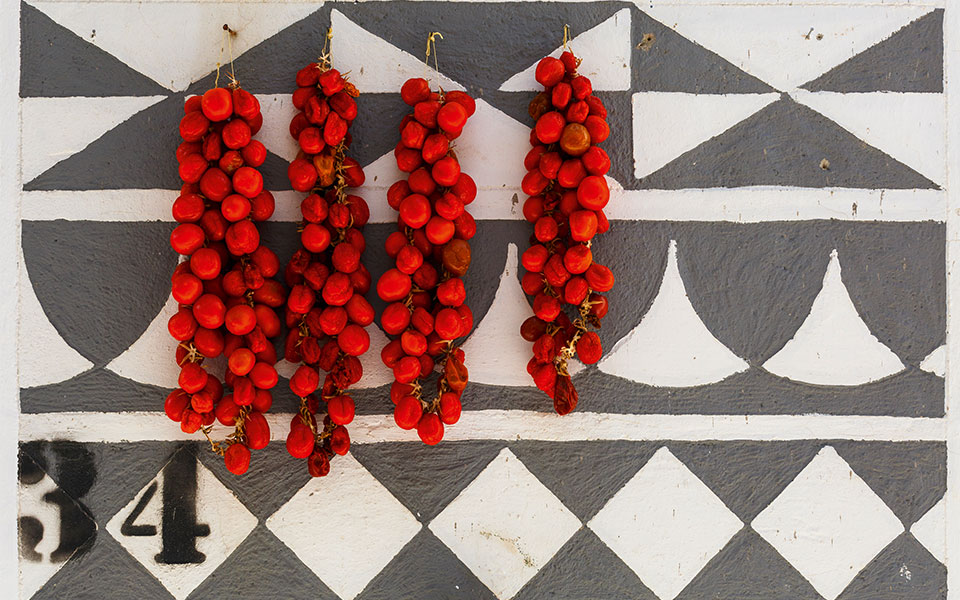
Bunches of Chios cherry tomatoes sun dry while hanging on the walls with traditional black and white motifs, in the village of Pyrgi.
© Getty Images/Ideal Image
The phrase “rocket war” seems to be synonymous with Chios. The famous rockets, which are stuffed with an explosive mixture of sulfur, nitro and charcoal and fired on the night of the Resurrection in the village of Vrontados, are famous throughout Greece. In the afternoon, the two rival crews parade side by side on the coastal road of Vrontados, after which they return to their respective “dens,” i.e., to the parishes of Aghios Markos and Panaghia Ereithiani, where the rocket launchers (the launch bases) have been set. Warning shots are fired at nine o’clock in the evening but the real war begins at midnight, when “Christos Anesti” (Christ is Risen) is heard and thousands of improvised rockets begin to trace spectacular curved lines in the night sky.
In order to have the best possible view of this spectacular event, it is worth getting to the Monastery of Aghios Makarios and to other parts of Mount Aepos, above the village. On Saturday afternoon, there is another impressive custom that takes place in the medieval mastic villages of Mesta and Olympi, as well as in Avgonyma: people make a big pile of dry wood in the central square to burn an effigy of Judas.
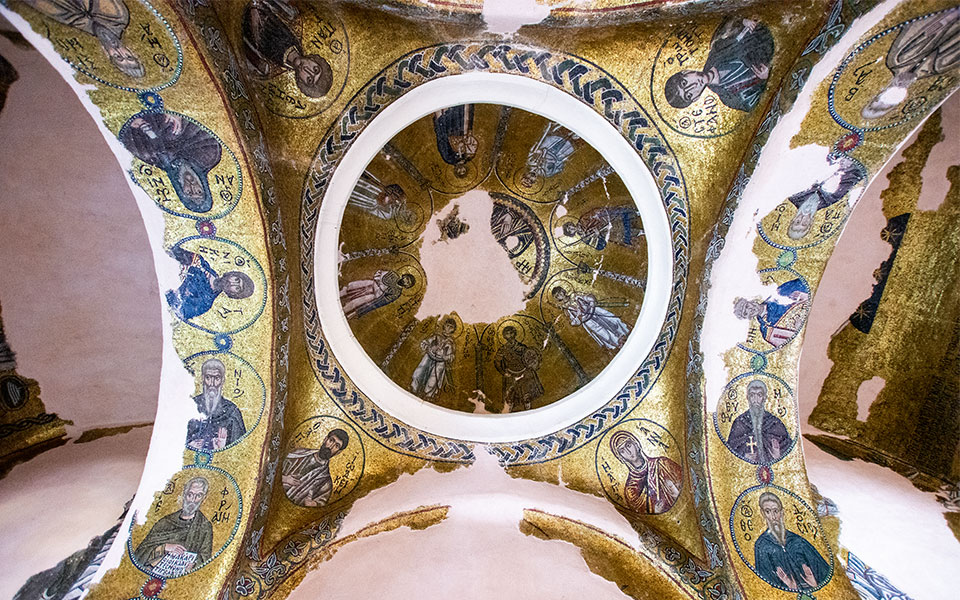
Inside Nea Moni of Chios, which is a UNESCO World Heritage Site.
© AFP/VISUALHELLAS.GR
However, you can avoid the chaos and mayhem of the “rocket war” and experience the Resurrection in Chios in a more evocative setting at Nea Moni, the great Byzantine monastery of Chios, included in the list of UNESCO World Heritage Sites. Here, the Resurrection is celebrated with a deep and reverent sense of peace and tranquility. Equally atmospheric are the liturgies of the Holy Week and Epitaphios, which you can also attend in the small churches of Kampos (Aghios Isidoros, Panaghia Pahia and Panaghia Kokorovilia), which are located within large estates of the area and used to be privately owned.
The procession of the Epitaphios (a large wooden bier representing the funerary bier of Christ), which winds its way through the alleyways, among the high walls and the citrus trees, is serene. Since at times there are not enough priests to cover all the churches, you should better ask the locals where the liturgy is going to take place. The procession of Epitaphios that takes place in Chios Town is captivating: the Epitaphii of Aghios Georgios in Kastro and of Aghii Victores, the Metropolis of Chios, are beautifully decorated. The processions of several parishes meet at the central square.
However, there is an alternative procession that takes place on the morning of Good Friday, in the abandoned village of Kydianta. Here, there is neither a priest nor chanters, therefore the residents of the village chant the praises and lamentation of the Virgin Mary and then walk in a procession three times around the church, the first for their ancestors, the second for their descendants, and the third for their offspring, with the cross being carried by a child. On Easter Tuesday, there is a procession of icons from chapel to chapel in the village of Leptopoda, in the north of the island.
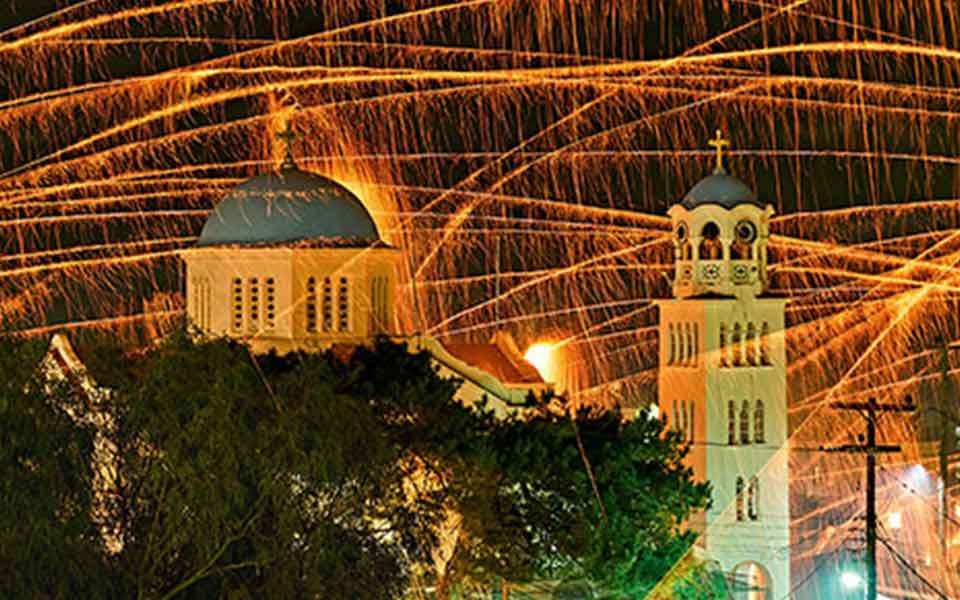
The spectacular "Rouketopolemos" (rocket war) in the village of Vrontados celebrates the Resurrection.
© Giorgos Tsafos
The fasting menu during Holy Week includes hortokeftedes (wild greens, spinach and local goat cheese croquettes) and raw fresh broad beans. When the fasting days are over, the fresh board beans can also be fried and mixed with fresh myzithra: a dish called tsohi. On Easter Sunday, the roasted goat is usually stuffed with rice, nuts, offal, fresh oregano and thyme.
There is also several varieties of fasting sweets. In addition to fruit preserves, which are found in abundance in Chios (pistachio, sour cherry, cherry, sour orange, aubergine, lemon blossom and mastic ypovrihio, a white chewy sweet that is served on a spoon dipped into a glass of crystal cold water), you will also find rodinia (marzipan flavored with mastic), tahinopitakia (filo pastry with tahini filling) and ravdolia (filo pastry with red pumpkin filling, sugar and cinnamon). Of course, there is no shortage of tsoureki (Greek Easter bread) with mastic, while for the children they make koutsa, a bun in the shape of a doll, with a red egg on the forehead.
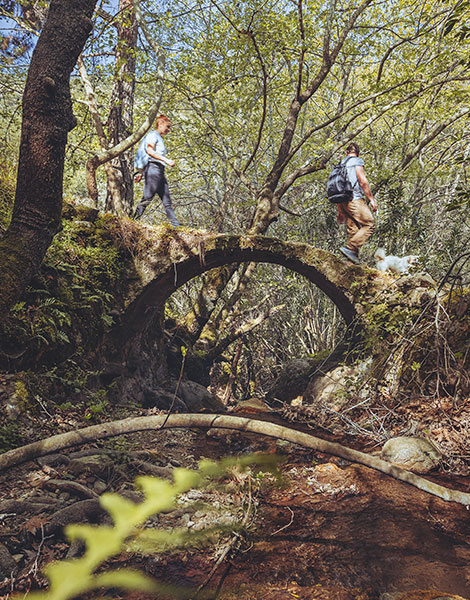
Hiking in the green gorge of Kampia.
© Nikos Boutsikos/Nidibou Photography
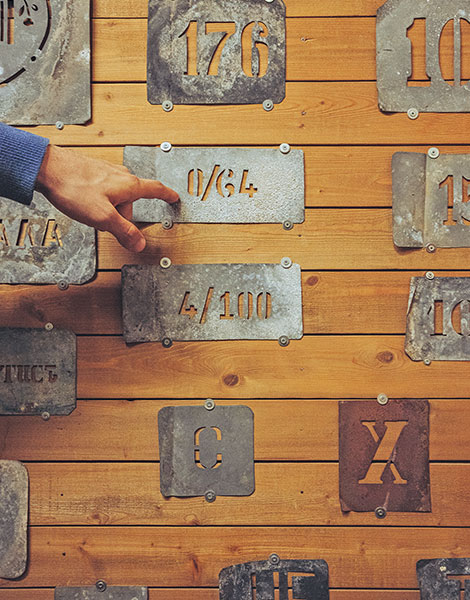
At the Citrus Museum, you will learn all kinds of interesting things about the fruit trade.
© Nikos Boutsikos/Nidibou Photography
Chios is referred to as “fragrant,” thanks to its rich flora that includes the citrus fruits of Kampos, mastic trees, herbs, hundreds of orchid species and four species of wild tulips (lalades) that grow here. In the spring, the island is in full bloom, although it is not obvious at first glance. You have to walk around and explore it. Local naturalist George Missetzis offers guided tours of the countryside, providing fascinating insight into the various flower species on route.
Chios is also ideal for hiking, although this activity has not been properly promoted on the island. For directions, you should contact the Association “Friends of Chios’ Trails” (Tel. (+30) 6938.605.170). The best preserved paths are the trail of Kampia Gorge (3km) and the Ancient Ottoman Empire trail, a cobbled path starting from Nea Moni and leading to Lithi (4km), which was used by the inhabitants during Ottoman rule.
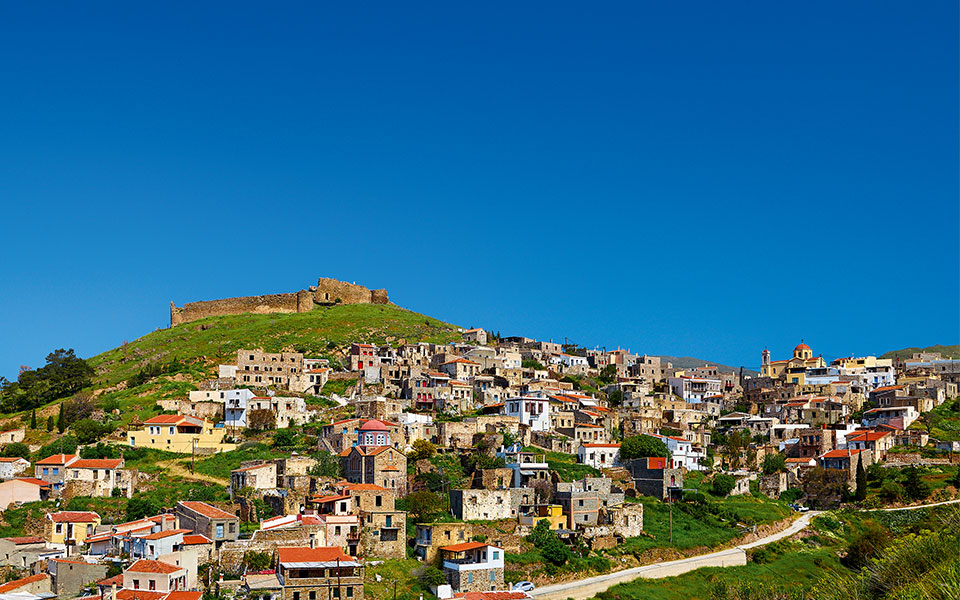
The beautiful Volissos in the north of Chios, famous for its castle.
© Giorgos Tsafos
Kampos is an idyllic place to visit in the spring, an orchard of 200 hectares that exudes aromas of orange, tangerine, lemon, bergamot and bitter orange, with scattered estates and beautiful mansions. At the Citrus Museum (Tel. (+30) 22710.332.02) within the Karalis Estate, you’ll discover the fascinating history of the citrus trade. Here, you will also find a café. At the Chios Mastic Museum in Pyrgi (Tel. (+30) 22710.722.12), which operates under the direction of the Piraeus Bank Group Cultural Foundation, you will encounter an equally charming and fragrant story, the history of mastic. In its well organized exhibition spaces, in addition to the touching relationship the locals have with mastic, you will also discover the interesting history of Chios Mastiha Growers Association. Furthermore, you should absolutely visit the beautiful mastic villages: the exquisite Mesta, famous for its labyrinthine narrow streets and medieval castle, Pyrgi, noted for its xista (the geometric and natural black and white motifs on the walls), and the villages of Olympi and Vessa.
It is also worth visiting Nea Moni, where you can attend a service or just admire its architecture and its magnificent mosaics. Ιf you have the time and you are in the mood to explore the area, you can pass by the ruined medieval settlement of Anavatos, which is also known as the Mystras of Chios and is currently under restoration. The village of Pityos, famous for its landmark eatery, Markelos Taverna (Tel. (+30) 22720.220.10 ), is well worth a visit, as well as the beautiful village of Volissos in the north, noted for its castle.
Spring offers a great opportunity to swim at the beaches of Mavra Volia, Apothika and Aghia Dynami, without the hordes of summer tourists – but bear in mind that the waters around Chios are extremely cold!
Perleas (Kampos, Tel. (+30) 22710.322.17, €130, breakfast included). This is one of the famous mansions of Kampos, dating back to 1640, with all its features preserved: the windlass well, the huge cistern and the citrus grove. Its welcoming anestatis (the caretaker of a Kampos estate who permanently lives in it), Vaggelis Xydas, will gladly talk to you about the history and architecture of the area.
Spitakia Cottages (Avgonyma, Tel. (+30) 22710.205.13, €100, breakfast included). It is a complex of beautiful tasteful houses, located in the little-known inland village of Avgonyma. The proprietor, George Missetzis, organizes excursions into nature, in search of rare species of plants. Here you will also find home-cooked breakfast and a rich collection of books related to nature.
MestaMastic (Mesta, Tel. (+30) 22710.760.09, €60, breakfast not included, open from Easter). It is a complex of rooms and suites with great ambiance, housed in old buildings of the medieval settlement, which have been carefully restored, thus maintaining their splendid arches, small openings and domes. MestaMastic offers a unique accommodation experience in its suites that exude discreet luxury and in its larger apartments featuring equipped kitchens.
Chandris (Chios Town, Tel. (+30) 22710.444.01, before Easter at €80, breakfast included while after Easter at 100 euros). Chandris Hotel is located in Chios Town and has various types of elegantly decorated rooms and suites with sea and port or town views. It also has a restaurant and offers modern amenities.
Almiriki (Lithi, Tel. (+30) 22710.731.24, www.almiriki.gr, €80, open from May). It is an assortment of rooms and suites with sea or mountain views, some with a simple, chic decoration and others in a rustic style. The complex has a café-bar and a swimming pool, while beauty and massage services are offered.
Agora Residence (Chios Town, Tel. (+30) 22711.071.84, €67 without breakfast and at 82 euros, breakfast included). It is a renovated mansion in the main pedestrian street of the town, with a wonderful garden, which is ideal for cocktails and drinks. Its rooms and apartments are spacious, high ceilinged and decorated with soft colors, antique furniture and a few modern touches.
Monolia Maisonettes (Aghios Ioannis, Tel. (+30) 6944.275.524, €80, three nights minimum stay). These five fully equipped maisonettes of 60 sq.m. each, featuring branded linens and decorated in a modern style, are located right by the sea.
Εnδόtera apartments (Chios Town, Tel. (+30) 6980.022.360, €80, breakfast not included). It’s a collection of beautiful apartments, located inside the Castle of Chios and decorated with furniture and fabrics in white and earth tones and with attention to detail. You can have your breakfast packed, upon request.
A decades-old ritual, Sikinos’ ferry dives...
A magical open-air cinema in Kimolos...
From family traditions to modern innovation,...
The signature dish of the island...